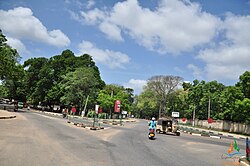Vavuniya District
|
Vavuniya District வவுனியா மாவட்டம் වවුනියා දිස්ත්රික්කය |
|
|---|---|
| Administrative District | |

|
|
 Location within Sri Lanka |
|
 DS and GN Divisions of Vavuniya District, 2006 |
|
| Coordinates: 08°50′N 80°30′E / 8.833°N 80.500°ECoordinates: 08°50′N 80°30′E / 8.833°N 80.500°E | |
| Country | Sri Lanka |
| Province | Northern |
| Capital | Vavuniya |
| DS Division | |
| Government | |
| • District Secretary | M. K. Bandula Harischandra |
| • MPs |
List
|
| • MPCs |
List
|
| Area | |
| • Total | 1,967 km2 (759 sq mi) |
| • Land | 1,861 km2 (719 sq mi) |
| • Water | 106 km2 (41 sq mi) 5.39% |
| Area rank | 15th (3.00% of total area) |
| Population (2012 census) | |
| • Total | 171,511 |
| • Rank | 22nd (0.85% of total pop.) |
| • Density | 87/km2 (230/sq mi) |
| Ethnicity(2012 census) | |
| • Sri Lankan Tamil | 141,269 (82.37%) |
| • Sinhalese | 17,191 (10.02%) |
| • Sri Lankan Moors | 11,700 (6.82%) |
| • Indian Tamil | 1,292 (0.75%) |
| • Other | 59 (0.03%) |
| Religion(2012 census) | |
| • Hindu | 119,286 (69.55%) |
| • Christian | 22,820 (13.31%) |
| • Buddhist | 16,688 (9.73%) |
| • Muslim | 12,341 (7.20%) |
| • Other | 376 (0.22%) |
| Time zone | Sri Lanka (UTC+05:30) |
| Post Codes | 43000-43999 |
| Telephone Codes | 024 |
| ISO 3166 code | LK-44 |
| Vehicle registration | NP |
| Official Languages | Tamil, Sinhala |
| Website | Vavuniya District Secretariat |
Vavuniya District (Tamil: வவுனியா மாவட்டம் Vavuṉiyā Māvaṭṭam; Sinhalese: වවුනියා දිස්ත්රික්කය) is one of the 25 districts of Sri Lanka, the second level administrative division of the country. The district is administered by a District Secretariat headed by a District Secretary (previously known as a Government Agent) appointed by the central government of Sri Lanka. The capital of the district is the city of Vavuniya.
Between 5th century BC and 13th century AD present day Vavuniya District was part of Rajarata. Vavuniya District was thereafter ruled by Vanniar Chieftains who paid tribute to the pre-colonial Jaffna kingdom. The district then came under Portuguese, Dutch and British control. In 1815 the British gained control of the entire island of Ceylon. They divided the island into three ethnic based administrative structures: Low Country Sinhalese, Kandyan Sinhalese and Tamil. The district, which was then called Vanni District, was part of the Tamil administration. In 1833, in accordance with the recommendations of the Colebrooke-Cameron Commission, the ethnic based administrative structures were unified into a single administration divided into five geographic provinces. Vanni District, together with Jaffna District and Mannar District, formed the new Northern Province.
...
Wikipedia
